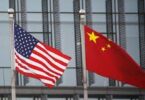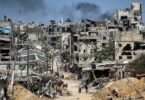Dmitry Ermakov & Mikhail Katkov
Because of the sanctions imposed agai-nst Moscow, the economy of the whole of Central Asia has fallen into the risk zone – close ties with Russia are affe-cting. The region understands this and, trying not to spoil relations with its northern neighbor, they are looking towards Turkey, China and the United States. However, while Ankara and Beijing have been investing in local projects for a long time, the deal with Washington has stalled at the stage of negotiations. What the Americans are trying to achieve – RIA Novosti understood.
Backstage visit
At the end of May, a US delegation visited four countries in the region—Kyrgyzstan, Kazakhstan, Uzbekistan, and Tajikistan. It was headed by Assistant Secretary of State for South and Central Asian Affairs Donald Lu. There were representatives of the Pentagon, the National Security Council, the Agency for International Development (USAID) and other organizations.
The Americans met with government officials, leaders of big business. The official goal is “strengthening US relations with the region and advancing joint efforts to build a more interconnected, prosperous, and secure Central Asia.”
Sanctions were also discussed – in the context of minimizing the negative impact on the region’s economy, as well as cooperation in the investment sphere. Details, however, are not disclosed.
This is not the first visit this spring: in April, Depu-ty Secretary of State for Civil Security, Democracy and Human Rights Uzra Zeya visited Kyrgyzstan. It was about some new cooperation agreement. In addition, about human rights, food security and the social role of women.
Fertile soil
Washington has long been eyeing Central Asia, but in the light of recent events, negotiations have noticeably intensified. Clearly, the Americans expect the region to loosen ties with Moscow and turn towards the West.
They really admit that the sanctions have already affected the economy in a bad way and in the future the negative effect may intensify. And if resource-rich Turkmenistan and Kazakhstan are resistant to such shocks, then for others, for example, the same Kyrgyzstan, the consequences are more tangible.
New jobs are not being created in the region, and the population is growing. According to various analytical institutions, three to four million people go to Russia for money – ten to fifteen percent of the economically active population of Central Asia.
“Sanctions affect the income of migrants and, as a result, the amount of transfers to their homeland,” explains Stanislav Pritchin, senior researcher at the Center for Post-Soviet Studies at IMEMO RAS. seriously escalate social tensions.
And although the republics do not want to spoil relations with Russia in such an economic situation, they are not ready to refuse the support of the West. The authorities are distancing themselves as much as possible from the Ukrainian crisis at the level of political statements, maintaining neutrality and trying to balance between the two geopolitical forces.
On two chairs
The financial sector is indicative – the most vulnerable to sanctions. In Kazakhstan, part of the assets of Russian financial organizations was frozen, and branches were transferred to local players. Attempts by Russian citizens to receive plastic cards from American and European payment systems in republican banks were immediately stopped by local authorities after signals from the West.
“In economic relations between Russia and the countries of the region, the problem of banking and financial transactions is becoming one of the most acute, especially at the household level,” says Pritchin. “This is a serious deterrent, for example, for the development of tourism. everywhere”.
The situation is similar in air traffic. Due to the risk of arrest of leased aircraft, Russian airlines use Sukhoi Superjet on routes to Central Asia, but these liners are few and the number of flights has noticeably decreased. Several local air carriers have completely suspended flights to Russia.
There were also problems with cultural ties. Ky-rgyzstan and Turkmenistan temporarily stopped broadcasting Russian TV channels. The reason is again in the sanctions of the West: the broadcasting of VGTRK TV channels was blocked on international satellites. The refusal to hold the parade on May 9 in Kazakhstan is symbolic – in the past two years due to covid, now – due to budgetary savings.
With its charter
According to analysts, taking advantage of the current situation, Washington is trying to expand its influence in Central Asia and oust the traditional players – Russia and China.
Thus, according to De-puty Foreign Minister And-rei Rudenko, Russian in-vestment in the region by 2021 reached $50 billion, China – $40 billion, of whi-ch 21.4 came from Kazak-hstan, People’s Daily repo-rts. If Russia invests in all spheres, then Beijing prefers infrastructure, primarily transport and logistics. In autumn, the construction of the China-Kyrgyzstan-Uzbekistan railway will begin. Chairman of the Cabinet of Ministers of Kyrgyzstan Akylbek Zhaparov called the project “the largest in the history of the republic.”
There is much less American money here. The US government website states that more than $9 billion in direct assistance has been provided to the Cen-tral Asian states “to support peace and security, democratic reform and economic growth, and humanitarian issues.”
In addition, during the COVID-19 pandemic, US-AID allocated $800,000 to develop medical laboratories in Central Asia and provided personal protective equipment for medical staff. And the Centers for Disease Control and Preve-ntion (CDC / CAR) sent 1.6 million to laboratories and to train health workers.
Washington understands that this is not enough, and, having failed to launch its own infrastructure projects in the region, it is trying to join the existing ones. For example, in the same USAID, they announced their interest in the transit of Chinese goods along the Trans-Caspian route, a logistics corridor bypassing Russia.
“Regional Security”
So far, we are talking about cooperation mainly in the economic and social spheres, but it is already clear now that Washington does not intend to limit itself to this.
The program “Central Asia plus the USA” (C5+1) appeared during the presidency of Barack Obama. They discussed regional security in the light of the neighborhood of the Afg-han Taliban, recalled infrastructure projects abandoned in the 1990s. At that time, it seemed logical that the Pentagon, which is at war in Afghanistan, seeks to gain a foothold in the region. According to The Wall Street Journal, even the deployment of bases in Central Asia was considered. However, after the flight from Kabul, plans changed.
In 2020, the text of the program was unexpectedly updated. And although the document published on the State Department website is a collection of beautiful words without specifics, political scientists are sure that the most interesting is contained in the classified chapters.
Experts do not rule out that the current loud statements about “democracy, friendship and mutual assistance” from the lips of pragmatic American officials serve only as a front for other, much more mundane goals.
It is no coincidence that, according to Central Asian media, during Donald Lu’s May visit, the topic of “providing regional security” was again raised – an issue that has traditionally been within the competence of the Kremlin.






